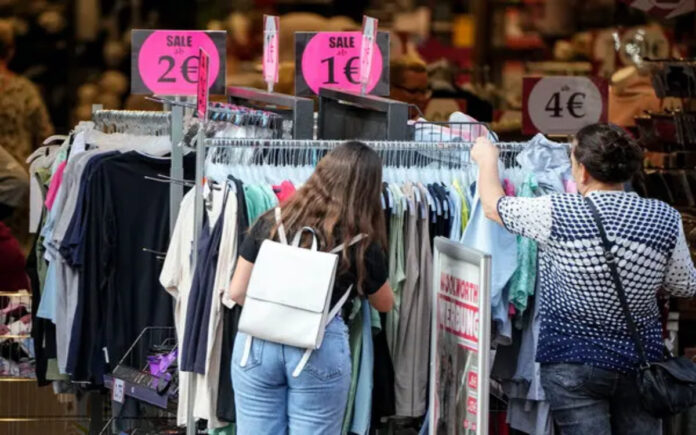Frankfurt/London: European families are currently sitting on an ever-increasing pile of savings, complicating hopes that consumer spending can invigorate the region’s economy as it continues to lag behind that of the United States. This rise in savings, occurring alongside significant income growth for consumers, contradicts traditional economic theories regarding consumer behavior, leading some experts to speculate about a potential paradigm shift that could negatively impact Europe’s future growth trajectory.
While some economists anticipate a return to pre-pandemic norms, others perceive a more permanent change in consumer behavior. The resolution of this savings puzzle will significantly influence Europe’s economic outlook. If households begin to spend their savings, which are currently at their highest rate since the pandemic’s peak, economic growth could surge. Conversely, if this spending shift fails to materialize, businesses that have been retaining labor for years might resort to layoffs, further dampening consumption and potentially triggering a downward economic spiral.
“When I think about prospects for activity going forward, consumer behavior really is the linchpin,” Bank of England policymaker Catherine Mann stated. “It has been the case over time that how the consumer goes is really how business investment goes, how the state of the fiscal side goes, and so forth.”
According to recent data, Eurozone households saved 15.7% of their disposable income in the second quarter, significantly higher than the pre-pandemic rate of around 12%. This savings trend has been steadily increasing over the past two years. Similarly, the savings rate in the UK has reached 10.0%, reflecting levels not seen since the pandemic, when consumers faced limited spending opportunities. In stark contrast, the personal savings rate in the United States has been declining this year, as consumers regain confidence in economic growth.
A Lasting Shift?
Identifying the underlying causes of this trend proves challenging, as some factors appear temporary while others may indicate a more lasting shift. Proponents of the temporary perspective argue that families are focused on rebuilding their cash reserves and wealth following the most severe inflation crisis in over a generation. Additionally, many are bracing for rising mortgage costs due to increased interest rates in recent years.
Consumer anxiety is further fueled by ongoing conflicts on Europe’s eastern border, fluctuations in energy prices, potential repercussions from the upcoming U.S. elections, instability in the Middle East, and a deepening industrial recession that threatens job security. Moreover, European savers are generally less experienced, making them more likely to invest in term deposits with attractive bank interest rates.
However, structural changes also raise concerns. The region has endured three significant shocks—namely the pandemic, Russia’s invasion of Ukraine, and rampant inflation—prompting many to adopt a more cautious approach to spending in the long term. Additional factors such as climate change, a declining working-age population, deglobalization, and the shift from industrial to service economies are likely to impact consumer confidence in a way that is not easily reversed.
Also Read | Ukraine Identifies North Korean Generals Assisting Russian Military Operations
A recent survey by the German Savings Banks Association revealed that when asked what they would do if unexpectedly given 500 euros, most respondents indicated they would save the money. “This is not temporary, nor just a snapshot, because we would then have gotten the opposite result,” said Ulrich Reuter, chairman of the association. “The younger generation is also insecure. They say: ‘What about climate change? What about my retirement provision? The older generation lives at my expense!'”
Household consumption in the EU rose by a mere 0.1% in the second quarter, while the investment rate has been on a steady decline.
Encouraging Developments
Despite these challenges, there are encouraging indicators on the horizon. Interest rates are decreasing, which may lead commercial banks to lower term deposit rates, potentially incentivizing some savers to spend. Additionally, sentiment gauges reveal a modest improvement in consumer expectations, and households are benefiting from the best income growth seen in over three years, as inflation trends back to around 2%.
Also Read | Community Notes on X Ineffective Against Misleading Election Claims, New Report Reveals
“Household confidence is gradually improving, and that might be a signal that the savings rate could be peaking,” said ECB policymaker Martin Kazaks. “That could be an early indication that consumption could turn around and drive the recovery.” The recent slight surprise in eurozone growth can be largely attributed to private consumption, which, although still weak, may have reached its lowest point.
Moreover, the labor market remains robust, despite some signs of softening in surveys and vacancy rates. “It’s possible that firms could start reducing their workforce in the absence of a recovery, but if that were to happen, that should already be taking place, given two years of near stagnation,” Belgian central bank Governor Pierre Wunsch noted. “Firms still struggle to fill vacancies, and people, especially skilled workers, find work relatively easily. My base case is for a recovery in 2025, and I would not exclude that it could surprise us on the upside at some point as people get comfortable with their higher real income growth.”



